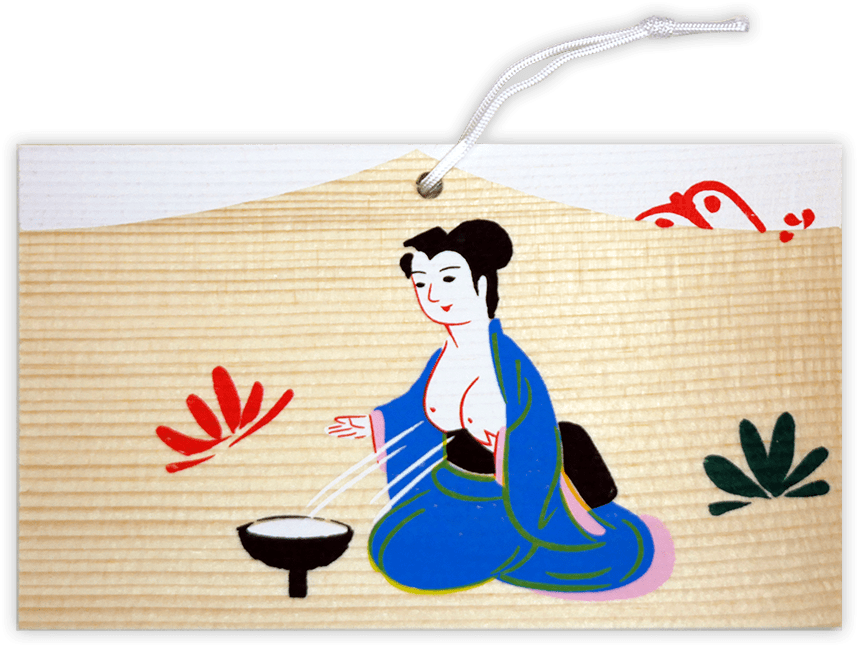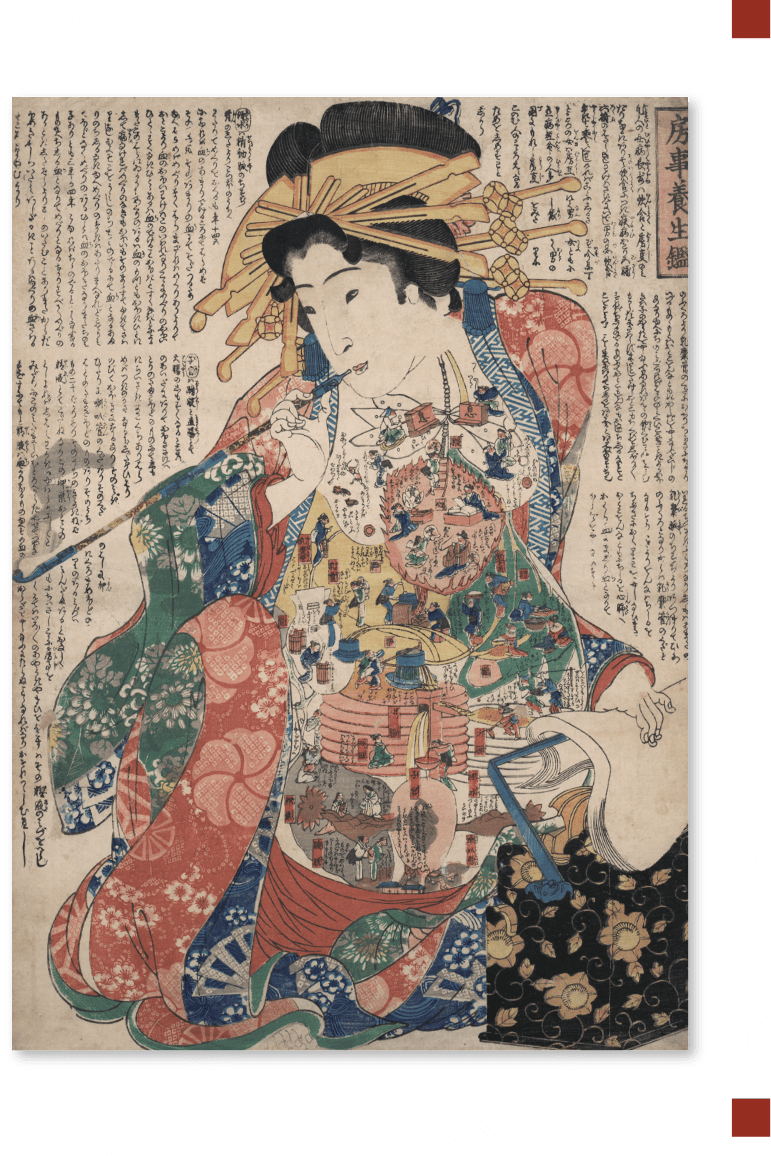
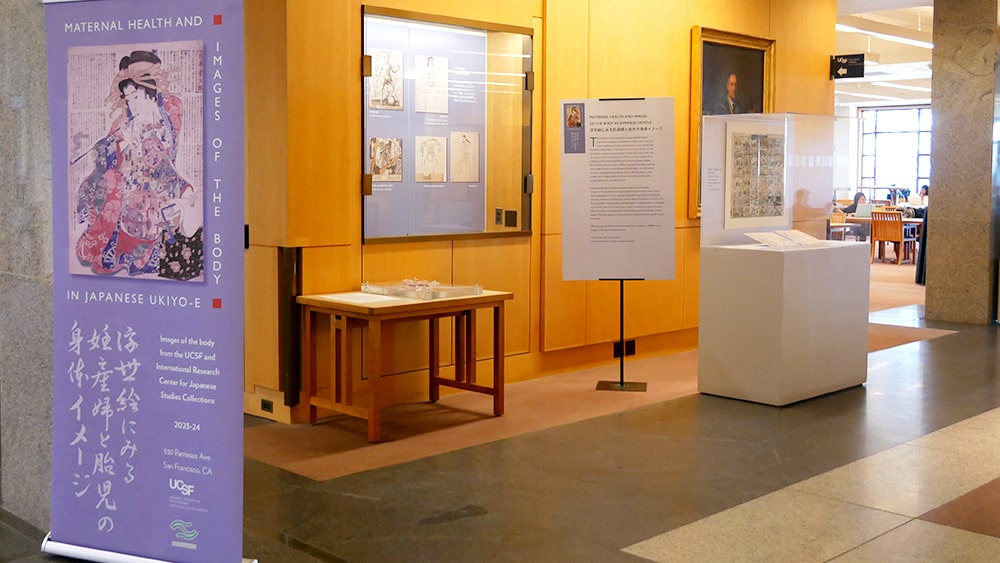
The UCSF Kalamanovitz Library
530 Parnassus Ave., San Francisco, CA 94143
This online museum has been generated based on “Maternal Health and Images of the Body in Japanese Ukiyo-e” (November, 2023 - late December, 2024), an exhibition held at the University of California, San Francisco (UCSF) Kalmanovitz Library, and is the result of joint research between the International Research Center for Japanese Studies (Nichibunken) and UCSF.
This exhibition centers around how women and their families experienced pregnancy and childbirth in early modern Japan, and also introduces how birth control methods such as abortion and infanticide (called mabiki, or “thinning out”) were viewed. We have chosen a selection of ukiyo-e artwork from the 1820s to the 1880s, the majority taken from the UCSF Japanese Woodblock Print Collection and the International Research Center for Japanese Studies (Nichibunken) collection. Ukiyo-e refers to a genre of drawings and woodblock prints from the Edo period (1603-1868) to the twentieth century. Each ukiyo-e designer often produced works on different subjects, such as contemporary social customs, popular Kabuki actors, and nature scenes.
During the Edo period, European anatomy books, such as Johabnn Remmelin’s Catoptrum Microcosmicum (1619), were translated from the Dutch edition (Pinax Microcosmographicus, 1667) to Japanese. Remmelin’s original (UCSF and McGill University collections) and Japanese translated editions (Nichibunken collection) show how the publishers had painstakingly printed organs on small paper flaps to holistically represent the bodies of men and women, as well as reproductive organs such as the uterus. Concurrent with the introduction of European anatomical knowledge, comical images of the body depicted in ukiyo-e were also produced and were popular among the masses.
We encourage you to enjoy these diverse images of pregnancy, childbirth, and bodily images from the Edo period through the first decades of the modern period.
-
Japanese
このオンライン・ミュージアムは、UCSF(カリフォルニア大学サンフランシスコ校)カルマノヴィッツ図書館(Kalmanovitz Library)にて、国際日本文化研究センター(日文研)とUCSFの共同研究の成果として開催した「浮世絵にみる妊産婦と胎児の身体イメージ(Maternal Health and Images of the Body in Japanese Ukiyo-e)」展(2023年11月~2024年12月末)を基に作成しました。
この展示では、江戸時代の女性やその家族が妊娠や出産をどのように経験したのか、また堕胎や間引きなどの出生コントロールが、当時どのように捉えられていたのかをあわせて紹介します。展示では、UCSF 所蔵日本木版画コレクションを中心に、日文研の所蔵資料なども加えて、おもに1820年代から1880年代の浮世絵を選んでみました。浮世絵は、江戸時代の風俗、歌舞伎役者、風景などを描いた絵画ジャンルで、肉筆画と版画に別れます。絵画ジャンルで、数多くの浮世絵師が多彩な作品を残しました。
また江戸時代には、ヨハン・レメリンの Catoptrum Microcosmicum (1619)のような西洋の解剖書が翻訳されました。レメリンの原本(UCSF及びMcGill大学所蔵)と翻訳版(日文研所蔵)からは、小さな紙片で丹念に臓器を作り込み、男女の身体、子宮の様子を表現したことが伝わってきます。一方で、このような解剖学的な知識とは別に、大衆の間では浮世絵に描かれた想像力豊かな身体イメージが人気を博しました。
展示を通して、江戸時代から近代初期にかけての妊娠、出産、そして身体の多彩な表現を、どうぞお楽しみください。
プロジェクト・リーダー
国際日本文化研究センター
安井眞奈美注記
*日本人の人名は、
姓・名の順で表記しています。 -
Chinese
浮世绘中的孕产妇和胎儿的身体形象
本次线上博物馆是以在UCSF(加州大学旧金山分校)卡尔马诺维茨图书馆举办的展览“浮世绘中的孕产妇和胎儿的身体形象”(从2023年11月到2024年12月)的基础上制作而成。而展览是国际日本文化研究中心(日文研)和UCSF的共同研究成果的汇报展示。
本次展览介绍了江户时代女性及其家庭如何经历怀孕和临盆,以及当时如何看待堕胎和杀婴等节育措施。本次展览的浮世绘主要是1820年代到1880年代的作品,其中主要来自加州大学旧金山分校日本木版画收藏,还有日文研的馆藏资料等。浮世绘是描绘江户时代的风俗、歌舞伎演员、风景等的绘画流派,分为原作画(肉笔画)和版画两大类。
在江户时代,已经有像约翰・雷默林(Johann Remmelin)的 Catoptrum Microcosmicum(1613)等西方解剖书的译本。雷默林的原作(加州大学旧金山分校以及麦吉尔大学所藏)以及译本(日文研馆藏)中用小纸片精心制作人体器官,表现男女身体,子宫的结构。此外,与解剖学知识不同的是浮世绘中描绘的想象力丰富的身体形象博得了民众的喜爱。
请大家尽情观赏本次展览所呈现的从江户时代到近代初期的怀孕、临盆以及多种多样的身体表现。
项目主持人
国际日本文化研究中心
安井真奈美注
*本展览中出现的日本人名均以姓氏、名字的顺序表示。
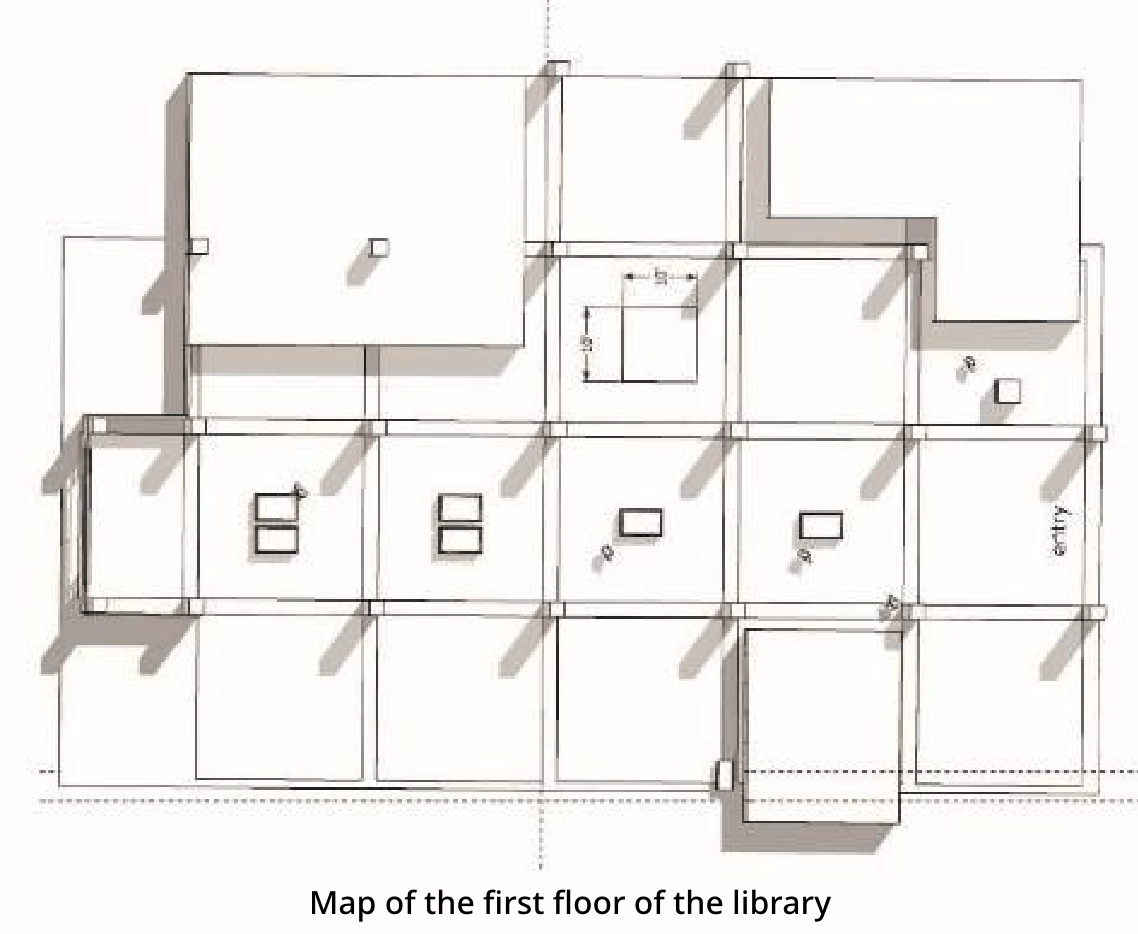
WOODBLOCK PRINT DEPICTING FETAL GROWTH, THE TAINAI TOTSUKI ZU or “TEN MONTHS FETAL CHART”
In East Asia a 40-week pregnancy is traditionally divided into ten months (four weeks each), in accordance with the lunar calendar. By the late-17th century, depictions of fetal growth at each stage of the ten months were widely circulated in texts such as Women’s Treasury (女重宝記, 1692). In these works, fetuses from the first to fourth month were depicted as Buddhist ritual implements, exhibiting religious influence. From the fifth to the tenth month fetuses were depicted in detail utilizing currently available obstetrical knowledge. Representations of fetal growth changed in late 19th-century ukiyo-e due to the influence and adoption of Western medical thought concerning pregnancy.
-
Japanese
胎内十月図と呼ばれた胎児の成長を描いた浮世絵
アメリカでは妊娠期間を9ヶ月と数えるが、これに対して東アジアでは伝統的に妊娠40週を4週ずつ10ヶ月に分けて、太陰暦のように計算する。江戸時代、身体は中国医学を基にした五臓六腑の考えで捉えられ、多くの身体図が描かれた。胎児の成長の様子を10ヶ月に分けて描いた胎内十月図は、17世紀末から女性の教訓書である『女重宝記』(1692年)などに掲載されて広く流布していた。妊娠4ヶ月目までの胎児を仏具で描くなど仏教の影響が見られたが、19世紀末になると、妊娠に関する西洋の医学知識を取り入れて、胎児の成長は詳細に描かれるようになっていく。
YASUI Manami 安井眞奈美
-
Chinese
描绘胎儿成长过程的浮世绘被称为胎内十月图
在美国妊娠期被算作 9 个月,而在东亚 40 周的妊娠期传统上被分为 10 个月,每个月四周,如农历算法一样。在江户时代,对于身体的认识基于中国医学的五脏六腑理论,由此描绘出了很多身体图像。把胎儿发育过程分为十个月来描绘的胎内十月图,刊载在像从17世纪末开始作为女教读物的《女重宝记》(1692年)等书中并广泛流传。从用佛具描绘怀孕第四个月之前的胎儿图像中可见佛教的影响;到了19世纪末,吸收了西方关于怀孕的医学知识后胎儿发育的过程被详细描绘。
YASUI Manami 安井真奈美
-
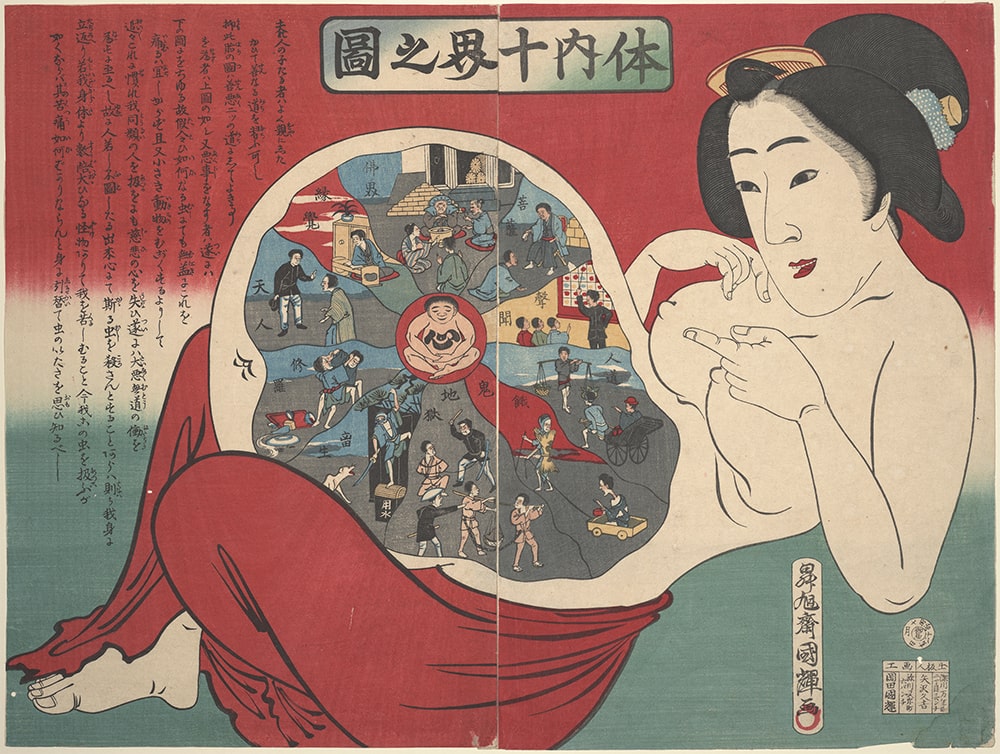
体内十界之圖 /
Ten Realms within the Body, 1885. -
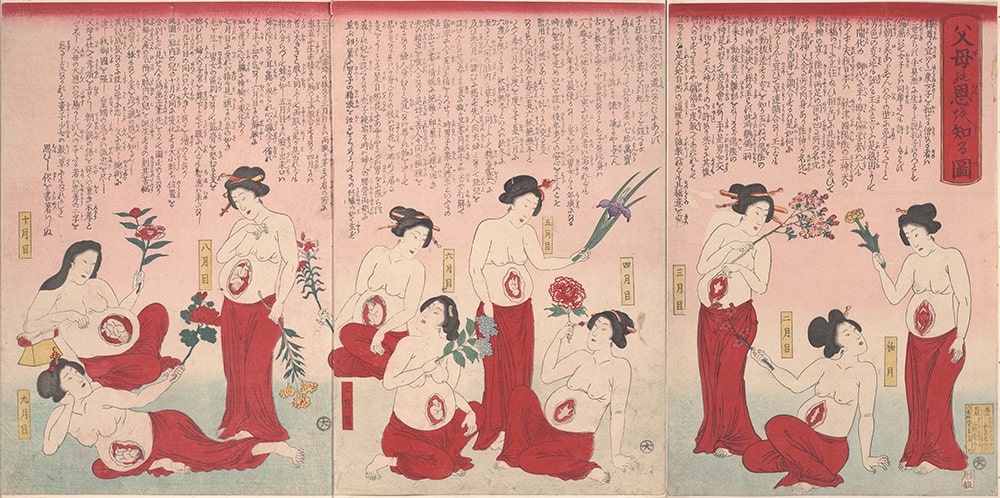
父母の恩を知る圖 /
Realize One’s Parental Love, 1880. -
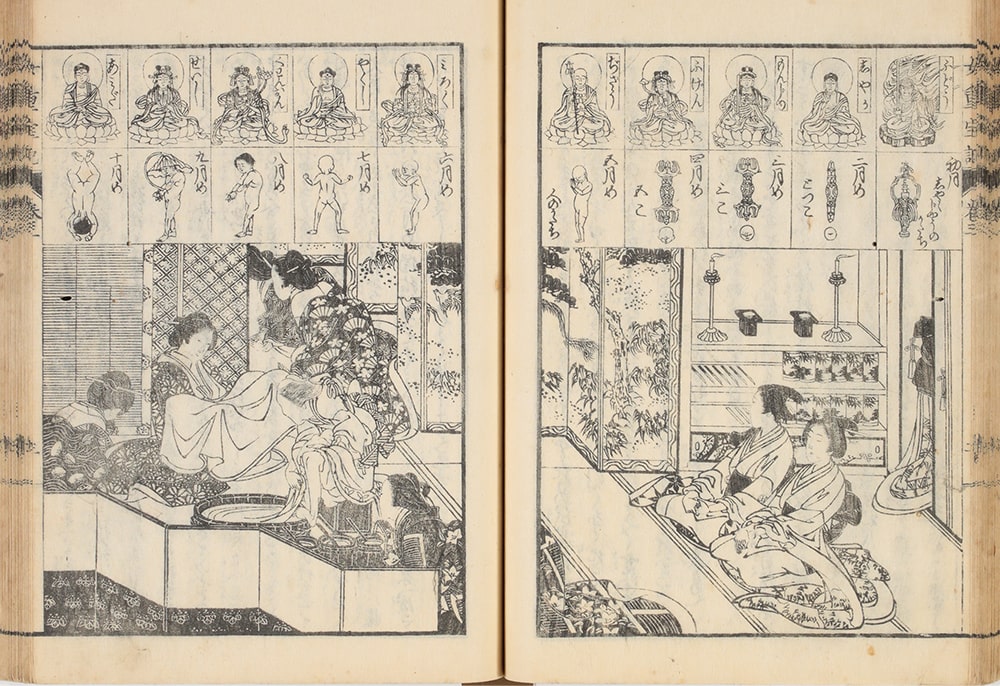
『女重宝記』 /
Women’s Treasury, 1692
(1847 ed. pictured).
PREGNANCY IN THE EDO PERIOD
During the Edo period (1603 – 1868), a woman would realize her pregnancy by observing common symptoms such as a missed period, the protrusion of the abdomen, and sensing fetal movement within her womb. At this stage she was pregnant, she would decide with her partner whether to terminate the pregnancy or carry the pregnancy to term. If the couple chose to continue the pregnancy, the woman would announce it publicly by wearing a maternity sash. Conversely, she could choose an abortion or infanticide (called mabiki or “thinning out”) with the help of a midwife who provided abortifacients, or by following other folk customs. However, later in the early modern period abortion and mabiki were banned by authorities and offenders were penalized. In late-18th-century Tsuyama (a city in present-day Okayama Prefecture, western Japan), pregnancies and childbirth in the region were monitored via reports made to local authorities (Sawayama 2005, 94). All miscarriages, neonatal deaths, and stillbirths were reported and reviewed as potential abortions or mabiki. In the instance of a stillbirth, for example, neighbors and other villagers would provide their testimonies or share their knowledge about the medical treatments they knew the woman had received (Sawayama 2005, 99-103).
-
Japanese
江戸時代の妊娠
江戸時代、懐胎(妊娠)は月経が止まる、お腹が大きくなる、胎動があるといった女性自身の身体感覚によって確認した。夫婦は妊娠を継続させるか堕胎を行うかを決め、妊娠を継続する場合は、妊婦は腹帯を締める帯祝いをして妊娠を公にした。一方、産まない場合、産婆に手伝ってもらったり、薬を飲んだり、民間習俗にしたがったりして堕胎もしくは間引きを行った。しかし近世後期には、藩によって堕胎、間引きは禁止され、罪とみなされるようになっていく。津山藩(現在の岡山県)では、18世紀後半に明確な罰則を伴う間引き禁止令を出し、妊娠・出産は藩に届け出を出させて監視した(沢山 2005, 94)。流産、死産、新生児死などは堕胎、間引きの可能性があるとして、藩によって検査されることとなった。たとえば死産の場合、医者や役人による赤子の死体の検分がなされ、検分結果の書類である「容躰書」の提出が求められた。また隣家や組合などの証言も求められ、妊娠・出産は共同体によっても監視されるようになった(沢山 2005, 99-103)。
YASUI Manami 安井眞奈美
-
Chinese
江户时代的妊娠
在江户时代,女性的怀胎(妊娠)是通过月经停止,腹部变大,有胎动等女性自身的身体感觉来确认的。夫妻双方决定是继续妊娠还是进行堕胎,如果继续妊娠,孕妇则进行系腹带的束带庆祝来公开妊娠的消息。与此相对,如果选择不生下来的话,通过请产婆帮助、药物或者根据一些民间习俗的方法进行堕胎或者杀婴。但是在近世后期,藩内禁止堕胎、杀婴,并逐渐被视为一种犯罪。津山藩(现在的冈山县),在18世纪后期颁布了带有明确惩罚规定的杀婴禁止令,怀孕、临盆都要向藩内申告,并受到监督(泽山 2005, p94)。像流产、死胎、新生儿夭折等有堕胎,杀婴可能性的情况,需要由藩进行检查。例如死胎的情况下,医生和官员会对婴儿的尸体进行验尸,并要求提交验尸结果的书面文件“容躾书”。另外,还要求邻居,村小组等提供证言,怀孕、临盆也由村组织进行监管(泽山 2005, p99-103)。
YASUI Manami 安井真奈美
-

妊婦炎暑戯 五頭十體の圖 /
Pregnant Women Playing in Summer Heat, or Five Heads with Ten Bodies, 1881. -

新柳二十四時 午後二時 /
Twenty-Four Hours at Shimbashi and Yanagibashi-2pm, 1880. -

逢夜鳫の聲 上(第1冊-7) /
Mating Calls of the Night Geese, vol. 1, image 7, 1822. -
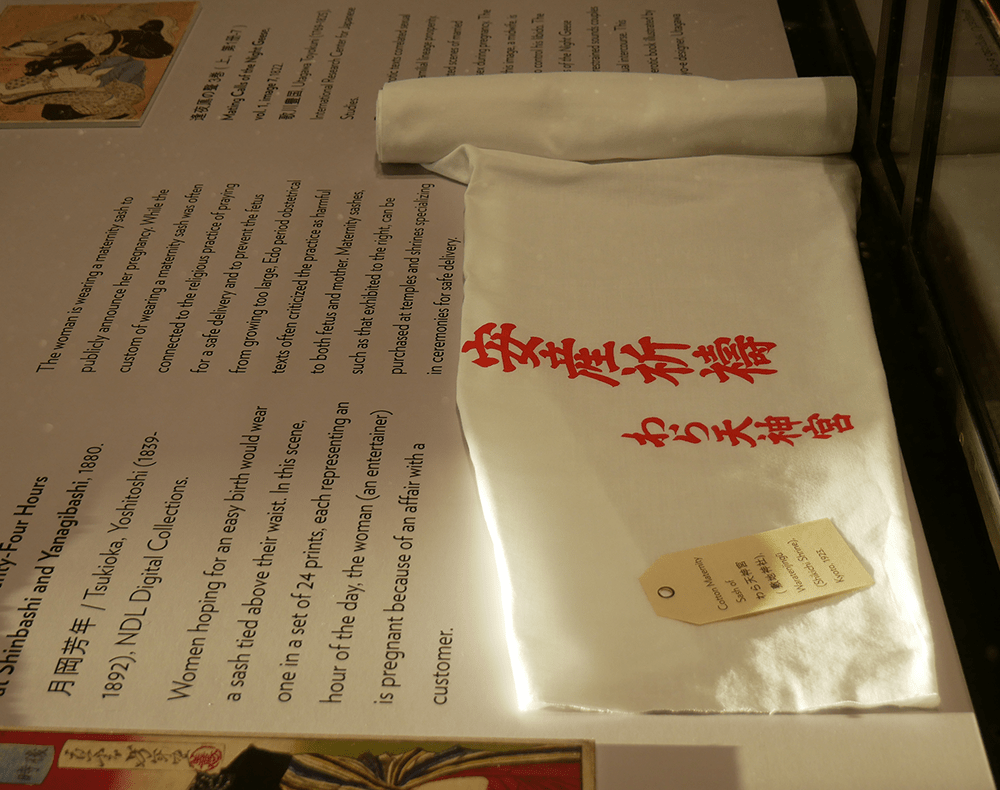
腹帯 /
Maternity Sash
CHILDBIRTH IN THE EDO PERIOD AND CHILDBIRTH IN STORIES
Since preserving family lineage was of the utmost importance in the Edo period, pregnancy and childbirth were regarded as using in good fortune. Erotic illustrations showed pregnant women having sexual intercourse, but childbirth itself was rarely depicted. Ukiyo-e images appeared either as mass-produced prints or as specially commissioned paintings. Passions of Sadness and Pleasure was one of twelve hand-drawn commissioned paintings. Birth Celebration at Suma for the Rustic Genji is a literary work depicting a childbirth scene involving the elite.
Social class determined the venue and circumstances of the delivery and the people involved. Unlike the births in the stories, childbirth for commoners usually occurred in a space separate from one’s living space, for example inside a storeroom, due to beliefs surrounding impurity. In these dimly lit spaces, midwives and experienced women from the neighborhood were present to aid with the delivery.
-
Japanese
江戸時代における現実の出産と物語上の出産
「家の繁栄」は江戸期の人々の最も重要な願いであり、妊娠と出産は大きな慶事であった。春画においても妊婦の性交は描かれるが、出産そのものが描かれたものは少ない。浮世絵は大量生産できる版画と、注文製作による肉筆画に大別される。「春情哀楽図」は注文製作による肉筆画である。「御誕生田舎源氏須磨の寿」は、物語の中での出産場面を豪華に描いた浮世絵版画である。 物語上の出産とは異なり、庶民の出産は、産の穢れのため日常の空間から隔離された、家の薄暗い部屋が選ばれた。助産のため、産婆や近所の経験豊かな女性たちが立ち会った。出産の姿勢、場所や介助者、協力者は階層によっても異なっていた。
ITASAKA Noriko, YASUI Manami
板坂則子・安井眞奈美 -
Chinese
江户时代现实中的临盆和物语中的临盆
“家族繁荣”是江户时期人们最重要的心愿,因此怀孕和临盆是天大的喜事。在春宫图中虽然描绘孕妇性交的画面,但是描绘临盆的场景的是少之又少。浮世绘大体分为能够批量生产的版画和定制的原作画。“春情哀乐图”是定制的原作画。“御诞生田舍源氏须磨之寿”中描绘了物语中临盆的场面,十分华丽。 庶民的临盆与物语中的临盆不同的是,因为临盆的不洁净而选择与日常空间隔离开来的、家中昏暗的房间。为了助产,会有接生婆或者近邻经验丰富的女性在场。阶层的不同,临盆的姿势,场所或者照顾者,协助者也不同。
ITASAKA Noriko, YASUI Manami
板坂则子・安井真奈美
-

春情哀楽図 第十図 出産 /
Passions of Sadness and Pleasure, 10 “Childbirth”. -

繪本おつもり盞 下(第3冊-5) /
Picture Book: Final Cup of the Party, 1826. -

御誕生田舎源氏須磨の寿 /
Birth Celebration at Suma for the Rustic Genji, 1867.
CONTROLLING BIRTHS IN THE EDO PERIOD
In the Edo period (1603-1868), women often made efforts to control their pregnancies and births. To avoid giving birth during the busy agricultural season, they could induce an abortion or enact infanticide (called mabiki). In districts where the authorities were concerned with population decline, there would be official campaigns against abortion and mabiki to increase the population. Local authorities regulayly attempted to control women’s reproductive bodies.
One district that had established clear penalties for abortion and infanticide in the mid-18th century revised its policy toward infanticide in the first half of the 19th century. The punishment was changed from a monetary fine to a reduction in status level, encouraging women to internalize a sense of “guilt” toward mabiki (Sawayama 2005, 96-97). To enforce feelings of guilt and reinforce the belief that mabiki was a deviation from human nature, authorities produced didactic texts on ema (votive tablets) that depicted images of women who had committed mabiki being tortured in hell. Measures against mabiki were adopted and rigorously enforced by the Meiji authorities (1868-1912), so by the end of the 19th century, mabiki practices had cased (Ōta 1997, 18).
-
Japanese
江戸時代における出生コントロール
江戸時代、女性たちは生活を維持するために、たとえば農繁期に出産しないよう出産時期を調整したり、避妊したりして受胎調節を行い、また堕胎や間引きなど出生をコントロールして、暮らしを維持した。諸藩、幕領などは、人口増加政策の一つとして、堕胎・間引きの禁止政策を開始するようになり、女性の身体は産む身体として管理されるようになった。堕胎・間引きに対して18世紀半ばに明確な罰則規定を設けていたある藩は、19世紀前半に間引き政策に対して方向転換を行い、過料による処罰から身分刑へとし、女性が「罪」意識を内面化するようにしむけた(沢山 2005, 96-97)。間引きをした女性が地獄で責め苦にあう絵などが描かれ、堕胎・間引きは人間としての逸脱であるとし、女性たちに罪意識を生じさせることにつながった。その後、間引き対策は明治政府によって引き継がれて徹底されたので、19世紀末までには間引き慣行は終息した(太田 1997, 18)。
YASUI Manami 安井眞奈美
-
Chinese
江户时代的计划生育
江户时代的女性为了维持日常生活,会采取例如不要在农忙时节生孩子、进行避孕等节育措施,或者堕胎、杀婴等进行计划生育,以此来保证日常。诸藩、幕领等为了增加人口采取的措施之一就是开始实行禁止堕胎・杀婴政策,把女性的身体作为生育的身体进行管理。在18世纪中期对于堕胎・杀婴设定明确惩罚规定的某些藩,在19世纪前半期改变了杀婴政策的方向,即从罚款到进行身份剥夺,引导女性将“罪”的意识内在化(泽山 2005, p96-97)。通过描绘杀婴的女性会堕入地狱受苦的绘画,让人们认为堕胎・杀婴是背离人性等都是为了让女性产生罪恶感。之后的明治政府继承并贯彻了防止杀婴的对策,到了19世纪末杀婴的惯例消失了(太田 1997, p18)。
YASUI Manami 安井真奈美
-

ひのゑ午歳生れ子のおしゑ書 /
Teaching on a Child Born in the Cyclical Year of Hinoe-uma, 1845. -

丙午歳子を産むの弁 /
Advice on Birth in the Year of Hinoe-uma, 1869. -

子かへしする人の地獄図 /
Portrayal of Karmic Retribution for Sinners of Infanticide, 1862. -
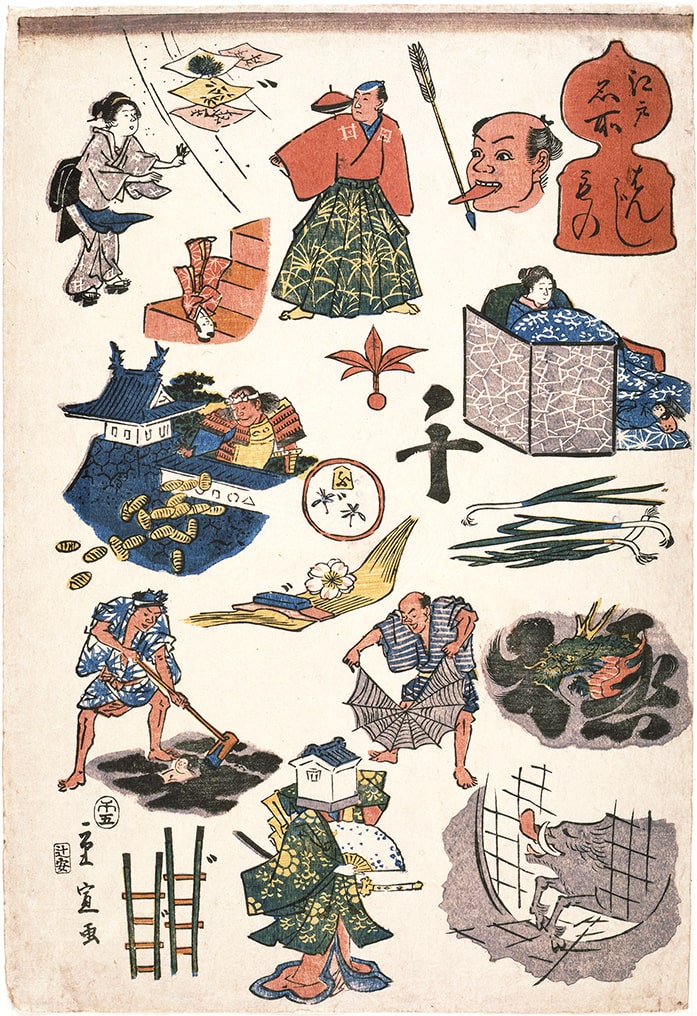
江戸名所はんじもの /
Puzzle of Famous Places in Edo, 1858.
PRE-AND POSTNATAL MEDICINES AND NOURISHING HEALTH
Many medicines were available for Japanese women during the Edo period, including those for general congestion in “the pathways of blood,” safe childbirth, inducing abortion, and regulating the body after childbirth. Just as with the congestion of ki (energy) in the body, early modern medicines that targeted blood stagnation were also used for medical conditions both before and after childbirth. Each medicine’s effectiveness would be labelled on its advertisement leaflets and signboards.
In 1868 (the first year of the Meiji era), the Meiji government banned midwives from assisting with abortions and selling medications. In addition, under the medical policy of 1874, known as Isei, authorities stipulated that only licensed pharmacists or practitioners were qualified to prescribe and compound medicines. At the same time, specialized pharmacy schools were established and access to Western medicines grew alongside Japanese and Chinese medicines.
-
Japanese
産前・産後の薬と養生
女性の身体に関する薬は妊娠中に服用する安産の薬、堕胎を引き起こす薬、産後の身体を整える薬、女性の身体の滞りを指す病の総称である「血の道」の薬など多種多様であった。気の流れと同様、血の道が滞らないようにする近世の身体観に基づいた薬が、産前・産後に限らず用いられた。売薬の引札(広告)や薬種商の看板などがそれぞれの薬の効能を伝えている。 明治政府は、1868(明治元)年に堕胎への産婆の関わりや売薬を禁止した。また1874(明治7)年の医制によって、明治政府は調薬できる者を薬舗主などに規定し、免許を受けるなど、その資格を明確にした。さらに明治に入って、和漢薬に代わり洋薬も増えたので、薬学教育を専門とする薬学校が設けられた。
YASUI Manami 安井眞奈美
-
Chinese
产前・产后的药物与养生
有多种多样的调理女性身体的药物,比如有怀孕期间服用的帮助安产的药物,引起堕胎的药物,调理产后身体的药物,治疗女性身体阻滞疾病也就是总称“血道”疾病的药物等。和气的流动相同,这是让血路不停滞的近世身体观为基础的药物,所以也不拘泥于产前·产后的时候用。卖药的宣传单(广告),药材商的招牌等都在宣传着不同药物的功效。 明治政府在1868(明治元)年禁止接生婆堕胎或者卖堕胎药等。并且根据1874(明治7)年医疗制度,明治政府明确了行医资格,例如规定了药店老板是能够制药的人、接受资格考试等。更甚者,进入明治时期由于西药取代日药和中药,因此专门从事制药教育的药剂学校应运而生。
YASUI Manami 安井真奈美
-

月見丸 婦人用薬 月ざらゑ /
Moon Viewing Monthly Revision Pill for Women. -

乳寳散 /
Breast-Treasure Pills: Medicine to Bring on Mother’s Milk. -

脾肝藥王圓 /
King of Drugs for Spleen and Liver, 1895.
COMMONER VIEWS OF THE BODY
In Edo Japan, the body was understood mainly through a worldview grounded in Sinitic (Chinese) medical thought by which the body is composed of organs known as the “five viscera (organs) and six entrails.” Each organ corresponds to the five elements, fire, metal, water, wood, and earth. To advise how one might engage in sex that nourishes health (“yōjō”), texts such as Model Sexual Practices for Good Health made use of small, animated characters to illuminate the functions of each organ. Similarly, texts such as Model Dietary Practices for Good Health also utilized the same illustrative technique to highlight the importance of proper eating and drinking.
-
Japanese
大衆の身体観
近世の日本では主に中国の医学知識や思想、世界観などを基に、身体は宇宙の元素「火・金・水・木・土」に基づいた五臓六腑として捉えられてきた。養生の考えをわかりやすく説くため、房事に注意する「房事養生鑑」や、飲食に注意する「飲食養生鑑」などを、臓器に小人を描いて説明した。
YASUI Manami 安井眞奈美
-
Chinese
大众的身体观
在日本近世时期,对于身体的认识主要以中国的医学知识、思想、世界观为基础,基于构成宇宙元素的“金・木・水・火・土”对应五脏六腑。为了更加简单易懂地科普养生,规劝注意房事的“房事养生鉴”,注意饮食的“饮食养生鉴”等,都把脏器画成小人来进行说明。
YASUI Manami 安井真奈美
-
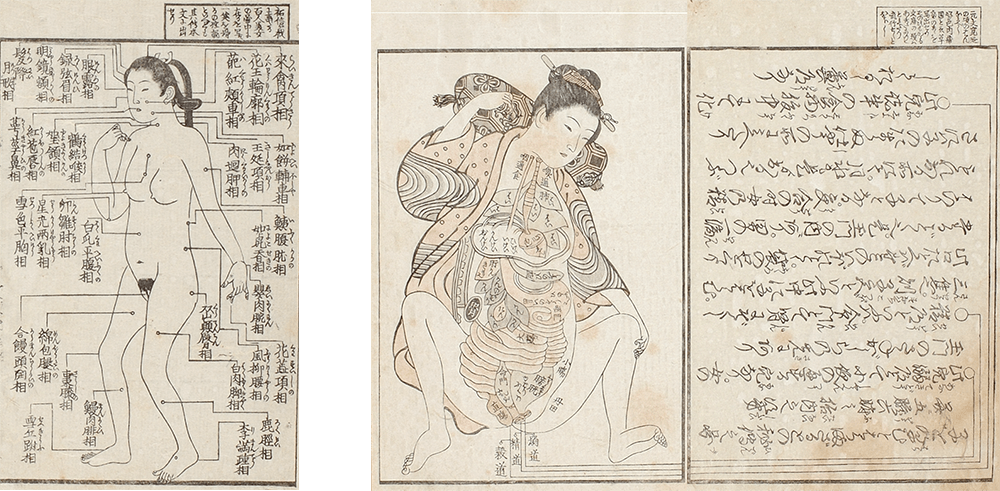
閨中紀聞枕文庫 /
News from the Bedroom: The Pillow Library. 左: 2編 [下] 右: 3編 [下] 1822-1832.
left: Part 2, Vol. 2; right: Part 3, Vol. 2. c. 1822-1832. -

房事養生鑑 /
Model Sexual Practices for Good Health, 1855. -

飲食養生鑑 /
Model Dietary Practices for Good Health, 1855.
INTRODUCTION OF ANATOMICAL BOOKS TO JAPAN
Johann Remmelin’s book of anatomy includes images of the male and female body. Through an ingenious layering technique, removeable flaps of paper portray individual organs, bones, blood vessels, and nerves which are placed on top of one another so readers could glimpse into the body’s internal structure. These organs on paper can also be removed one flap at a time.
-
Japanese
解剖書の日本への導入
ヨハン・レメリンの解剖書は、男女の身体図が描かれたもので、皮膚の部分の紙をめくると、骨、血管、臓器など内臓の造りが見えるようになっている。また紙片で作られた臓器が取り出せるようにもなっている。日本にも伝わり、翻訳がなされた。
YASUI Manami 安井眞奈美
-
Chinese
解剖书引入日本
这是约翰雷默林著的解剖学书籍,是描绘男女身体的图,如果翻开皮肤部分的纸,就可以看到骨头、血管、脏器等内脏结构。并且纸片做得脏器是可以取出来的。也传到了日本,被翻译成日文。
YASUI Manami 安井真奈美
-

REMMELIN’S ANATOMICAL BOOK
Male body /
Catoptrum Microsmicum, 1619. -

REMMELIN’S ANATOMICAL BOOK
Female body /
Catoptrum Microsmicum, 1619. -

REMMELIN’S ANATOMICAL BOOK
Female reproductive organs /
Catoptrum Microsmicum, 1619. -

Male body /
『和蘭全躯内外分合図』 Anatomical Atlas of the Whole Body, 1772. -
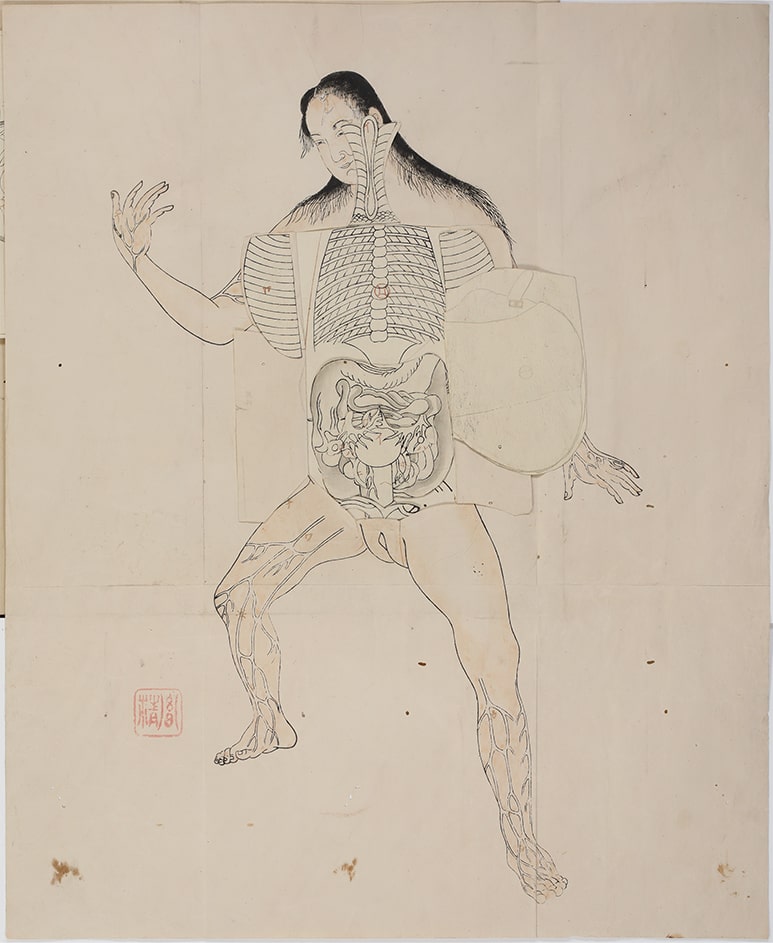
Female body /
『和蘭全躯内外分合図』 Anatomical Atlas of the Whole Body, 1772. -
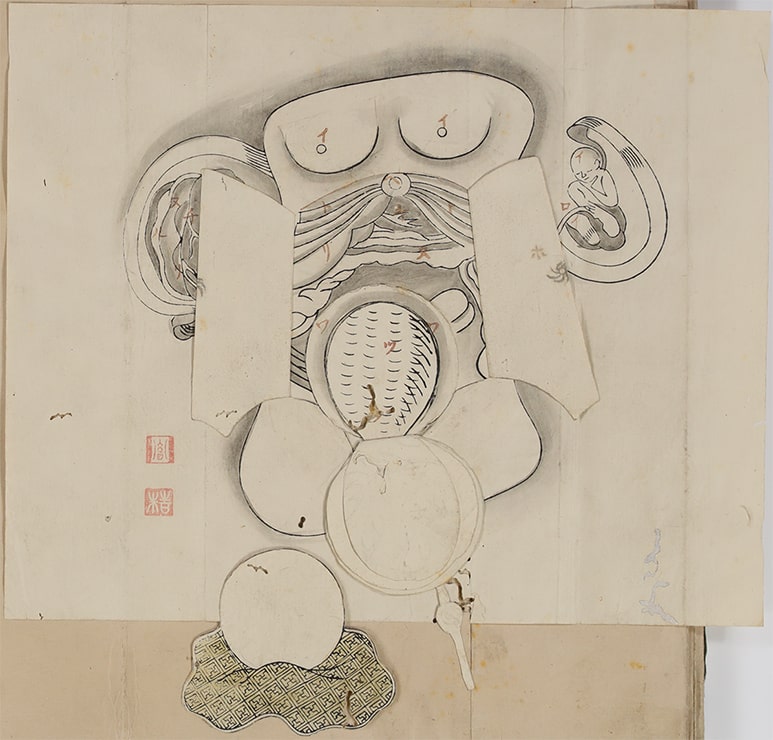
Female reproductive organs /
『和蘭全躯内外分合図』 Anatomical Atlas of the Whole Body, 1772. -
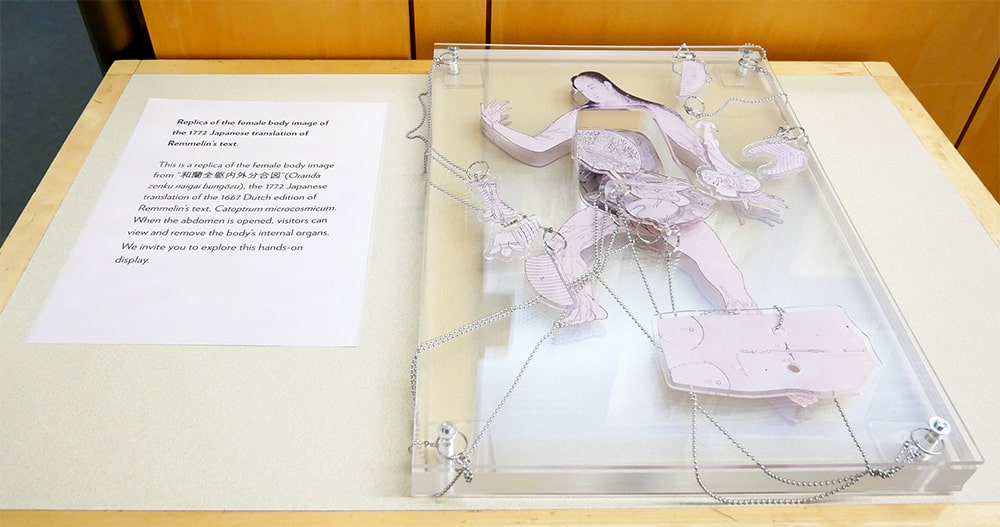
Replica of “和蘭全躯内外分合図” (Oranda zenku naigai bungōzu, Anatomical Atlas of the Whole Body)
IMAGES OF THE FETUS
Over the course of the Edo period (1603-1867), a revolution in printing and illustration technology led to the popularization of visual images. Beyond the phenomena around them, people increasingly sought out images of other worlds. Popular religious thought in particular emphasized a cycle of birth, life, and death within the so-called “Six Realms” of existence.
Apart from the Six Realms, another liminal space was imagined, existing between this world and the beyond. Fetuses and children who died before reaching adulthood were portrayed as ending up there.
-
Japanese
胎児のイメージ
江戸時代(1603-1867)を通して、木版印刷の革命的な技術進歩によって様々な画像の普及がもたらされた。身のまわりの画像から、日常的に目に見えない別世界のイメージが段々求められるようになった。民衆仏教の思想には、六道を巡る誕生・生・死の繰り返しが強調されていた。 六道以外に、この世とあの世を隔てる境界的な場所が想定され、そこに大人になる前に死んでしまった子ども達や胎児の行くところが描かれた。
Lawrence MARCEAU ローレンス・マルソー
-
Chinese
胎儿的形象
整个江户时代(1603-1867)随着木版印刷技术革命性的进步,各种各样的图像得到了普及。从身边的画像到逐渐追求日常生活中看不见的另一个世界的形象。而在民间佛教思想中,强调诞生・生・死的六道轮回。 除了六道之外,还描绘了未长大成人就夭折的婴儿和儿童的去向,即设想了在这个世界和那个世界相隔的边界性质的地方。
Lawrence MARCEAU 劳伦斯·马索
-

極楽双六 善悪双六 極楽道中図絵 /
Good and Evil Game: Pictorial Journey to Buddhist Paradise, 1858. -

好色一代女 第6巻 /
The Life of an Amorous Woman, vol. 6, 1686. -

本朝酔菩提全伝 巻之一 /
Drunken Enlightenment in This Realm: Complete, vol. 1, 1809.
Bibliography / Works Cited
English
- Chin, Gail F. 2014 “As a Vessel of the Dharma, I am a Woman: A Visual Parody from Nineteenth-Century Japan,” in Artibus Asiae 74-1, pp. 221-236.
- Drixler, Fabian 2013. Mabiki: Infanticide and Population Growth in Eastern Japan, 1660-1950. Oakland: University of California Press.
- Inagaki Shin’ichi 1988. Edo no asobie (Caricatures in Edo). Tokyo: Tokyo Shoseki.
- Kobayashi Tadashi 2019. Ukiyoe (Ukiyoe). Tokyo: Yamakawa Shuppansha.
- Ogino Miho 2008. “Kazoku keikaku” e no michi: Kindai Nihon no seishoku o meguru seiji (A Path to “Family Planning”: Politics of Reproduction in Modern Japan). Tokyo: Iwanami Shoten.
- Ōta Motoko 2007. Kodakara to kogaeshi: Kinsei nōson no kazoku seikatsu to kosodate (Child as Treasure and Returning Back Child as Infanticide: Family Life and Childrearing in Early Modern Japanese Villages). Tokyo: Fujiwara Shoten.
- Ōta Motoko (ed.) 1997. Kinsei Nihon Mabiki kankō shiryō shūsei (A Collection of Early Modern Materials on Mabiki Practices). Tokyo: Tōsui Shobō.
- Sawayama Mikako 2005. Sei to seishoku no kinsei (Sex and Reproduction in the Early Modern Period). Tokyo: Keisō Shobō.
- Shirane, Haruo (ed.) 2002. Early Modern Japanese Literature: An Anthology , 1600-1900. New York: Columbia University Press.
- Hara Sanshin, 1995. “Hara Sanshin-bon to Remerin kaibōsho〔taishō〕(Hara Sanshin’s book and Remmelin’s anatomical book [compared]).” In Hara, Sanshin, ed. Nihon de hajimete hon’yaku shita kaibōsho , (The First Anatomical Book Translated in Japan). Kyoto: Shibunkaku Shuppan.
- Yasui Manami, 2017. “Minkan shinkō ni miru shintai no zuzōka to zōkeika: Yōkai-ga no haikei wo motomete (Iconization and Modeling of the Body in Folk Beliefs: In Search of the Background of Yōkai Drawings)”, In Tenri daigaku kōkogaku minzokugaku kenkūshitsu, ed. Mono to zuzō kara saguru Kaii /yōkai no tōzai (The East and West of Kaii and yōkai Explored through Objects and Images), 111-138. Tokyo: Bensei Shuppan.
- Yasui Manami, 2022-1. Nerawareta shintai: Yamai to yōkai to jendā . (The Targeted Body: Diseases, Yōkai, and Gender). Tokyo: Heibonsha.
- Yasui Manami 2022-2. “Nimpu to taiji no shintai o kashikasuru: Meiji jidai shoki no nishikie o chūshinni (Visualizing the Body of Pregnant Women and Infants: Focusing on Multi-colored Woodblock Prints in the Early Meiji Period. In Yasui, Manami and Lawrence Marceau, ed. Sōzō suru shintai: Shintai imēji no hen’yō (The Body as Subject: Vol. 1, Body Image Transformed), 98-123. Kyoto: Rinsen Shoten.
-
Japanese
引用・参考文献
- 稲垣進一 1988『江戸の遊び絵』東京書籍
- 荻野美穂 2008『「家族計画」への道―近代日本の生殖をめぐる政治』岩波書店
- 太田素子編 1997『近世日本マビキ慣行史料集成』刀水書房
- 太田素子 2007『子宝と子返し―近世農村の家族生活と子育て』藤原書店
- 小林忠 2019『浮世絵』山川出版社
- 沢山美果子 2005『性と生殖の近世』勁草書房
- 原三信 1995「原三信本とレメリン解剖図(対照)」原三信編『日本で初めて翻訳した解剖書』思文閣出版、pp.17-58
- 安井眞奈美 2017「民間信仰にみる身体の図像化・造形化―妖怪画の背景を求めて」天理大学考古学・民俗学研究室編『モノと図像から探る怪異・妖怪の東西』勉誠出版、pp.111-138
- 安井眞奈美 2022『狙われた身体―病いと妖怪とジェンダー』平凡社
- 安井眞奈美 2022「妊婦と胎児の身体を可視化する―明治時代初期の錦絵を中心に」安井眞奈美/ローレンス・マルソー編『想像する身体 上巻 身体イメージの変容』臨川書店、pp.98-123
- Chin, Gail F. 2014 “As a Vessel of the Dharma, I am a Woman: A Visual Parody from Nineteenth-Century Japan,” in Artibus Asiae 74-1, pp. 221-236.
- Drixler, Fabian 2013. Mabiki: Infanticide and Population Growth in Eastern Japan, 1660-1950. University of California Press
- Shirane, Haruo (ed.) 2002. Early Modern Japanese Literature: An Anthology, 1600-1900. Columbia University Press
-
Chinese
引用・参考文献
- 稻垣进一 1988《江户的游绘》东京书籍
- 荻野美穗 2008《“家族计划”的道路——近代日本生殖的政治》岩波书店
- 太田素子 1997《近世日本杀婴惯例史料集成》刀水书房
- 太田素子 2007《子宝和子返——近世农村的家族生活和育儿》藤原书店
- 小林忠 2019《浮世绘》山川出版社
- 泽山美果子 2005《性和生殖的近世》劲草书房
- 原三信 1995“原三信本和雷默林解剖图(对照)”原三信编《日本最初翻译的解剖书》思文阁出版, pp.17-58
- 安井真奈美 2017“民间信仰中身体的图像化·造形化——寻求妖怪画的背景”天理大学考古学·民俗学研究室编《从物和图像中探索怪异·妖怪的东西》勉诚出版, pp.111-138
- 安井真奈美 2022《被觊觎的身体——疾病、妖怪和性别》平凡社
- 安井真奈美 2022“孕妇和胎儿身体的可视化——以明治时代初期的锦绘为中心”安井真奈美/劳伦斯·马索编《想象的身体 上卷 身体形象的变容》临川书店, pp.98-123
- Chin, Gail F. 2014 “As a Vessel of the Dharma, I am a Woman: A Visual Parody from Nineteenth-Century Japan,” in Artibus Asiae 74-1, pp. 221-236.
- Drixler, Fabian 2013. Mabiki: Infanticide and Population Growth in Eastern Japan, 1660-1950. University of California Press
- Shirane, Haruo (ed.) 2002. Early Modern Japanese Literature: An Anthology, 1600-1900. Columbia University Press
Acknowledgments
English
This exhibition is part of the NIHU Interactive Museums initiative of the National Institutes for the Humanities (NIHU), and serves as an open collaborative research output with the University of California, San Francisco (UCSF). We wish to acknowledge and warmly thank the following individuals and organizations for their cooperation in planning and executing the related exhibition, “Maternal Health and Images of the Body in Japanese Ukiyo-e” (in alphabetical order):
The Edo-Tokyo Museum
The Hotei Hall at the Shitennō-ji Temple, Osaka
McGill University
The National Diet Library Digital Collections
The National Institute of Japanese Literature
The Rikkyo University Ikebukuro Library
The Kannon Hall at Bandai-ji Temple in Fukuyama, Hiroshima Prefecture
Wara Tenjin Shrine (unofficial name of Shikichi Jinja), Kyoto
INAGAKI Shin’ichi
HAYAKAWA Monta
Michael FORNITZ
YASUI Manami
International Research Center for Japanese Studies
-
Japanese
謝辞
-
この展示は、人間文化研究機構「開かれた人間文化研究を目指した社会共創コミュニケーションの構築」事業の一環として、カリフォルニア大学サンフランシスコ校(UCSF)との共同研究の成果を公開したものです。「浮世絵にみる妊産婦と胎児の身体イメージ(Maternal Health and Images of the Body in Japanese Ukiyo-e)」 展にご協力いただきました下記の皆様に厚く御礼申し上げます(敬称略)。
-
江戸東京博物館
国文学研究資料館
国立国会図書館デジタルコレクション
四天王寺布袋堂(大阪市)
磐台寺観音堂(広島県・福山市)
マギル大学(McGill University)
立教大学池袋図書館(乱歩文庫)
わら天神宮(敷地神社・京都市)
稲垣進一
早川聞多
Michael FORNITZ
国際日本文化研究センター 安井眞奈美
-
-
Chinese
谢辞
-
本次展览是由人间文化研究机构“致力于开展人类文化研究的社会共创交流构建”事业以及加州大学旧金山分校(UCSF)赞助的。在此特别鸣为本次展览“浮世绘中的孕产妇和胎儿的身体形象”(Maternal Health and Images of the Body in Japanese Ukiyo-e)提供帮助的各大单位以及各位同仁(敬称略)。
-
国立国会图书馆数字资源
国文学研究资料馆
京都的藁天神宫(敷地神社・京都市)
江户东京博物馆
立教大学池袋图书馆(乱步文库)
麦吉尔大学
磐台寺观音堂(广岛县・福山市)
四天王寺布袋堂(大阪市)
稻垣进一
早川闻多
Michael FORNITZ
国际日本文化研究中心 安井真奈美
-
Exhibition Project Team
English
-
Project Team Leader and Director
YASUI Manami(Professor, Nichibunken)
-
International Research Center for Japanese Studies (Nichibunken) Exhibition Project Team
-
Supervision/Chief Editor (English Translation) and Description
Lawrence MARCEAU(Collaborative Project Team Member, Nichibunken, Visiting Researcher, Art Research Center, Ritsumeikan University.)
-
Historical Investigation and Description
ITASAKA Noriko(Professor, Emerit, Senshu University)
-
Description and English Translation
LEE I Zhuen Clarence(Associate Professor, Yamanashi Gakuin University, International College of Liberal Arts)
SAKA Chihiro(Nichibunken, Project Research Fellow)
-
Chinese Translation (Online Exhibition)
SONG Dandan (Postdoctoral Fellow, Nichibunken)
-
Timeline and Description
Michaela KELLY (Collaborative Project Team Member, Nichibunken)
-
Exhibition Planning Advisor
FUJIOKA Hiroshi(Program-Specific Researcher, Kyoto University Graduate School of Asian and African Area Studies (ASAFAS))
-
Model Production and Exhibition Administration
ONO Ayako(Assistant Administrative Staff, Research Division, Nichibunken)
-
Model Production and Research Administration
SAKAI Yoko(Unit Head, Projects Unit, Research Cooperation Section, Nichibunken)
-
Special Thanks to;
-
Japanese Description Inquiry
SAWAYAMA Mikako (Guest Researcher, Research Institute for the Dynamics of Civilizations, Okayama University)
-
Calligraphy Titles
TOMISHIMA Chikako(Research Support Unit, Research Cooperation Section, Nichibunken)
-
Transcription
NAKATA Yuka (Assistant Technical Staff, Nichibunken)
-
Photography
Database Management Unit, Library Resources Section, Nichibunken
-
Library Resource Arrangement
Library Services Unit, Library Resources Section, Nichibunken
-
Online Museum Support
SUGANO Hiroko (Supervisor, Public Relations Unit, General Affairs Section, Nichibunken)
-
University of California, San Francisco (UCSF) Exhibition Project Team
-
Director
Polina ILIEVA (Associate University Librarian for Collections, University Archivist, UCSF Library)
-
Curation and Outreach
Peggy TRAN-LE (Research and Technical Services Managing Archivist, UCSF Library)
Jessica CROSBY (Outreach and Marketing Coordinator, UCSF Library)
Lupe SAMANO (Intern, Archives and Special Collections, UCSF Library)
Edith ESCOBEDO (Project Archivist, UCSF Library)
Kirk HUDSON (Library Facilities Manager, UCSF Library)
-
Exhibition Design
Mark MCGOWAN (Exhibition Graphic Designer)
-
Exhibition Installation
Denise FORDHAM (Fordham & Associates Fine Art Services LLC)
-
Arrangement, Advising, and Administration
Stephen RODDY (Professor, University of San Fransisco)
Special Thanks to;
-
Brian DOLAN (Professor and Chair of the Department of Humanities and Social Sciences, UCSF)
-
Alicia MURASAKI (Assistant Vice Chancellor, Campus Planning and Campus Architect, Co-Chair of the UCSF Art Committee, UCSF)
-
Won HA (Vice Chancellor of Communications, UCSF)
-
Japanese
展示プロジェクトチーム
-
プロジェクト代表・総括
安井眞奈美(日文研、教授)
-
国際日本文化研究センター(日文研)プロジェクトチーム
-
英語監修・解説執筆
ローレンス・マルソー(日文研、共同研究員、立命館大学アート・リサーチセンター、客員協力研究員)
-
資料考証・解説執筆
板坂則子(専修大学、名誉教授)
-
解説執筆・英語翻訳
李奕諄・クラレンス(山梨学院大学、准教授)
坂知尋(日文研、プロジェクト研究員)
-
年表作成・英語翻訳
ミケーラ・ケリー(日文研、共同研究員)
-
展示計画アドバイザー
藤岡洋(京都大学大学院アジア・アフリカ地域研究研究科、特定研究員)
-
オンライン展示中国語翻訳
宋丹丹(日文研、博士研究員)
-
レプリカ作成・展示事務
小野絢子(日文研、事務補佐)
-
レプリカ作成・研究協力事務
左海陽子(日文研、事業係係長)
-
協力
-
日本語解説考証
沢山美果子(岡山大学文明動態学研究所客員研究員)
-
毛筆題字
冨嶋千佳子(日文研、研究支援係)
-
資料翻刻
仲田侑加(日文研、技術補佐員)
-
資料撮影
日文研資料課電子情報係
-
資料貸出手配
日文研資料課資料利用係
-
オンライン展示協力
菅野裕子(日文研、広報係主任)
-
カリフォルニア大学サンフランシスコ校(UCSF)展示プロジェクトチーム
-
総括
ポリーナ・イリエヴァ(UCSF図書館、准大学司書、大学アーキビスト)
-
展示準備・広報
チャン・レー・ペギー(UCSF図書館、調査・技術サービス統括アーキビスト)
ジェシカ・クロスビー(UCSF図書館、アウトリーチマーケティングコーディネーター)
ルぺ・サマノ(UCSF図書館、アーカイブ・特殊資料インターン)
イーディス・エスコべド(UCSF図書館、プロジェクトアーキビスト)
カーク・ハドソン(UCSF図書館、図書館ファシリティマネージャー)
-
展示レイアウト・デザイン
マーク・マゴワン(展示グラフィックデザイナー)
-
展示設営
デニス・フォーダム(フォーダム&アソシエイツ・ファインアートサービス)
-
準備・交渉・運営
ステファン・ロディー(サンフランシスコ大学、教授)
協力
-
ブライアン・ドーラン(UCSF、人文社会学部長・教授)
-
アリシア・ムラサキ(UCSF、副学長補佐・キャンパス建築士・芸術委員会共同会長)
-
ウォン・ハ(UCSF、副学長)
-
-
Chinese
“浮世绘中的孕产妇和胎儿的身体形象”展览项目组成员
-
项目代表·总策划
安井真奈美(国际日本文化研究中心(日文研)、教授)
-
国际日本文化研究中心(日文研)项目组成员
-
英语监修·解说词撰写
劳伦斯·马索(日文研、共同研究员、立命馆大学艺术研究中心、客座合作研究员)
-
资料考证·解说词撰写
板坂则子(专修大学、名誉教授)
-
解说词撰写·英语翻译
李奕谆 克拉伦斯(山梨学院大学、副教授)
坂知寻(日文研、项目研究员)
-
年表制作·英语翻译
米凯拉·凯莉(日文研、共同研究员)
-
展览策划顾问
藤冈洋(京都大学大学院亚非地域研究研究科、特定研究员)
-
线上展览的中文翻译
宋丹丹(日文研、博士研究员)
-
复制品制作·展览文秘
小野绚子(日文研、行政助理)
-
复制品制作·研究协助员
左海阳子(日文研、事务部门主管)
-
协助者
-
日语解说词的考证
泽山美果子(冈山大学文明动态学研究所客座研究员)
-
毛笔题字
富岛千佳子(日文研、研究协力员)
-
资料翻刻
仲田侑加(日文研、技术助理)
-
资料摄影
日文研资料科电子信息部门
-
资料借阅安排
日文研资料科资料利用部门
-
线上展览协助
菅野裕子(日文研、宣传科主任)
-
加州大学旧金山分校(UCSF)展览项目成员
-
总策划
波琳娜·伊利耶娃(UCSF图书馆、准大学图书管理员、大学档案员)
-
展览准备·宣传
佩吉·陈黎(UCSF图书馆、研究与技术服务部管理档案员)
杰西卡·克罗斯比(UCSF图书馆、外联和营销协调员)
卢佩·萨马诺(UCSF图书馆、档案和特殊资料部实习生)
伊迪丝·埃斯科贝多(UCSF图书馆、项目档案员)
科克·休斯顿(UCSF图书馆、图书馆设施管理人)
-
展览布置・设计
马克·麦高文(展览平面设计师)
-
展览布置
Denise FORDHAM (Fordham & Associates Fine Art Services LLC)
-
展览设施
丹妮丝·福德汉姆(福特汉姆联合美术服务有限责任公司)
-
准备·洽商·运营
斯定文·罗迪(旧金山大学、教授)
特别鸣谢
-
布莱恩·多兰(UCSF、人文社会学系主任·教授)
-
阿莉西亚·村崎(UCSF、副校长助理·校园规划与设计师·艺术委员会联合主席)
-
元河(UCSF、副校长)
-














